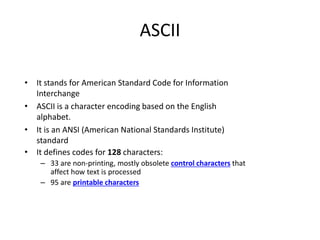Melden
Teilen

Empfohlen
Empfohlen
Weitere ähnliche Inhalte
Was ist angesagt?
Was ist angesagt? (20)
Andere mochten auch
Andere mochten auch (20)
Open and online: connections, community and reality 

Open and online: connections, community and reality
Presentiaon task sheduling first come first serve FCFS

Presentiaon task sheduling first come first serve FCFS
Ähnlich wie 4 character encoding-ascii
Ähnlich wie 4 character encoding-ascii (17)
The ASCII code used by most computers uses the last seven positions .pdf

The ASCII code used by most computers uses the last seven positions .pdf
How to Interpret the Contents of Stored Memory Data

How to Interpret the Contents of Stored Memory Data
Mehr von irdginfo
Mehr von irdginfo (20)
4 character encoding-ascii
- 1. ASCII • It stands for American Standard Code for Information Interchange • ASCII is a character encoding based on the English alphabet. • It is an ANSI (American National Standards Institute) standard • It defines codes for 128 characters: – 33 are non-printing, mostly obsolete control characters that affect how text is processed – 95 are printable characters
- 2. ASCII • ASCII is a seven-bit code, meaning it uses patterns of seven binary digits (a range of 0 to 127 decimal) to represent each character. – When ASCII was introduced, many computers used eight-bit bytes as the native data type. The eighth bit was commonly used as a parity bit for error checking on communication lines 0 1 0 0 0 0 0 1
- 3. ASCII • Different versions of ASCII were created for different applications – Windows-1252 - Changed some of the character encodings – Mac OS Roman - Extended the encoding beyond 7 bits (the 7-bit characters were the same)
- 4. ASCII
- 5. ASCII • The good – Encode all characters in 1 byte – Almost every computer supports/supported ASCII • The bad – Can only encode English (with a limited number of accented characters)